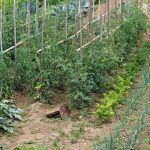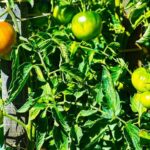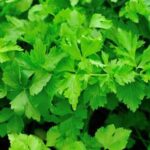As gardeners, one of the key factors we must consider for successful vegetable growth is temperature. Understanding at what temps do vegetable gardens grow best is crucial for optimizing plant health and yield. In this article, we will explore the significance of temperature in vegetable gardening, including the ideal temperature range for different types of vegetables, the effects of temperature extremes, and practical tips for extending the growing season.
The impact of temperature on vegetable garden growth cannot be overstated. Temperature plays a critical role in the germination, growth, and fruiting of plants. It directly affects processes such as photosynthesis, water uptake, and nutrient absorption, ultimately influencing the overall health and productivity of your vegetable garden. By gaining a deeper understanding of temperature requirements for different vegetables, gardeners can make informed decisions to create optimal growing conditions and maximize their harvest.
Throughout this article, we will delve into the specific temperature range that is optimal for various types of vegetables. We will also discuss the differences in temperature requirements between warm-season and cool-season vegetables, as well as how extreme temperatures can impact plant growth. Additionally, practical tips on how to extend the growing season through temperature manipulation will be provided to help avid gardeners make the most out of their vegetable gardens.
Understanding the Ideal Temperature Range
When it comes to growing a successful vegetable garden, understanding the ideal temperature range for different types of vegetables is crucial. Each type of vegetable has its own specific temperature requirements for optimal growth and productivity. Here are some general guidelines to keep in mind when considering at what temps do vegetable gardens grow best:
- Warm-season vegetables: Vegetables such as tomatoes, peppers, cucumbers, and squash thrive in warmer temperatures. These types of vegetables typically prefer daytime temperatures between 70-85°F (21-29°C) and nighttime temperatures above 60°F (15°C). Planting these vegetables when the soil has warmed up to around 60°F (15°C) is ideal for promoting healthy growth.
- Cool-season vegetables: On the other hand, vegetables like lettuce, spinach, kale, and broccoli prefer cooler temperatures. These cool-season vegetables generally grow best when daytime temperatures range from 55-75°F (13-24°C) and nighttime temperatures stay above freezing. In fact, some cool-season vegetables can tolerate light frost, making them suitable for early spring or late fall planting.
- Temperature fluctuations: It’s important to note that while each type of vegetable has an optimal temperature range, they may still be able to tolerate some fluctuations in temperature. However, extreme swings in temperature can negatively impact plant growth and overall productivity. Monitoring the weather patterns in your region can help you plan your planting schedule accordingly.
By understanding the specific temperature requirements for different types of vegetables, gardeners can make informed decisions about when to plant and how to create the ideal growing conditions for their crops. Whether it’s providing shade during hot summer days or using row covers to protect against frost in colder months, paying attention to temperature variations is essential for a successful vegetable garden.
Warm-Season vs Cool-Season Vegetables
When it comes to growing vegetables, understanding the temperature requirements for different types of plants is crucial. Warm-season and cool-season vegetables have specific temperature ranges in which they thrive best. Understanding these differences is essential for successful gardening and a bountiful harvest.
Warm-season vegetables, such as tomatoes, peppers, and eggplant, generally grow best when temperatures are consistently above 70°F (21°C). These plants prefer warm soil and air temperatures to establish strong roots and produce fruit. In contrast, cool-season vegetables like lettuce, spinach, and kale prefer cooler temperatures ranging from 45-75°F (7-24°C). These plants can tolerate light frost and thrive in the milder conditions of spring and fall.
It’s important for gardeners to be mindful of these temperature differences when planning their planting schedule. Planting warm-season vegetables too early when temperatures are still cool can stunt growth or even kill the plants. Conversely, planting cool-season vegetables too late in the season when it’s too warm can cause them to bolt or turn bitter. By understanding the specific temperature requirements for each type of vegetable, gardeners can maximize their chances of a successful harvest.
| Vegetable Type | Ideal Temperature Range |
|---|---|
| Warm-Season Vegetables | Above 70°F (21°C) |
| Cool-Season Vegetables | 45-75°F (7-24°C) |
Effects of Temperature Extremes
Extreme temperatures can have a significant impact on the growth and productivity of vegetable gardens. When temperatures are too high or too low, it can disrupt the normal physiological processes of plants, leading to stunted growth, reduced yields, and even plant death. Understanding the effects of temperature extremes is crucial for successful gardening and maximizing the potential of vegetable crops.
High temperatures can be detrimental to vegetable gardens, especially during the hot summer months. Excessive heat can cause stress to plants, leading to wilting, sunscald, and reduced fruit set in many types of vegetables. Additionally, high temperatures can also increase water requirements, making it challenging to maintain adequate soil moisture levels for optimal plant growth. On the other hand, low temperatures can also pose challenges for vegetable gardens, particularly for warm-season vegetables that thrive in warmer conditions.
To address the impact of extreme temperatures on vegetable growth and productivity, gardeners must implement strategies to protect their plants from adverse conditions. This may include providing shade during periods of intense heat, using row covers or cloches to trap warmth during cool weather, and selecting suitable varieties that are better adapted to specific temperature ranges.
By being proactive in managing temperature extremes, gardeners can help mitigate potential damage to their vegetable gardens and promote healthy plant growth throughout the growing season.
In addition to direct effects on plants, extreme temperatures can also impact soil health and nutrient availability. High temperatures can accelerate soil moisture evaporation and lead to increased nutrient leaching, while low temperatures may slow down microbial activity and nutrient uptake by plant roots. Therefore, maintaining balanced soil temperature is equally important for overall vegetable garden success.
Tips for Extending the Growing Season
When it comes to extending the growing season for vegetables, manipulating temperature is a crucial factor to consider. Different types of vegetables have specific temperature requirements for optimal growth and productivity. Understanding these ideal temperature ranges can help gardeners make informed decisions about when and where to plant their crops.
For warm-season vegetables such as tomatoes, peppers, and eggplants, the ideal temperature range for growth is between 70-85°F (21-29°C). These plants thrive in warmer weather and will struggle to grow if temperatures consistently drop below 60°F (15°C).
On the other hand, cool-season vegetables like lettuce, spinach, and kale prefer cooler temperatures ranging from 50-70°F (10-21°C). Planting these crops during the appropriate season and providing shade during hot spells can help maintain the ideal temperature range for their growth.
It’s also important to be mindful of the impact of extreme temperatures on vegetable gardens. Frost can be detrimental to many vegetable plants, so protecting them with row covers or cold frames can help extend the growing season into the fall months. Additionally, excessive heat can cause stress and reduce yields in certain crops. Using techniques like mulching and providing adequate irrigation can help moderate soil temperature and protect plants from the effects of extreme heat.
Overall, understanding the ideal temperature ranges for different types of vegetables is essential for successful gardening. By carefully managing temperatures through planting timing, shade structures, and other techniques, gardeners can effectively extend the growing season and maximize their harvests.
| Vegetable Type | Ideal Temperature Range (°F) | Ideal Temperature Range (°C) |
|---|---|---|
| Warm-Season Vegetables | 70-85°F | 21-29°C |
| Cool-Season Vegetables | 50-70°F | 10-21°C |
Microclimates and Temperature Variations
Microclimates can have a significant impact on the temperature in vegetable gardens, affecting the growth and productivity of various crops. A microclimate refers to the climate conditions within a small, localized area that may differ from the surrounding area. Understanding microclimates is essential for successful gardening, as it allows gardeners to make informed decisions about plant selection and placement based on the unique temperature variations within their garden.
There are several factors that contribute to the creation of microclimates, including topography, proximity to bodies of water, and the presence of buildings or structures. For example, a garden located on a slope may experience differences in temperature at higher and lower elevations. Similarly, plants situated near a pond or lake may benefit from milder temperatures compared to those in areas further away.
Factors influencing microclimates:
- Topography: Hills, slopes, valleys
- Proximity to bodies of water: Lakes, ponds, rivers
- Urban heat islands: Cities and urban areas
- Vegetation: Trees, shrubs
Understanding these factors can help gardeners maximize the potential of their vegetable gardens by identifying areas with optimal temperatures for different types of crops. By taking advantage of microclimates, gardeners can extend their growing season and cultivate a wider range of vegetables throughout the year.
Moreover, utilizing tools such as shade cloth, row covers, or even strategically placed plantings can help mitigate the impact of extreme temperatures within specific microclimates. By paying attention to these variations in temperature and making adjustments accordingly, gardeners can create an ideal environment for their vegetables to thrive regardless of external climatic conditions.
Using Tools and Techniques to Control Temperature
When it comes to maintaining the ideal temperature for your vegetable garden, there are several tools and techniques that can be used to regulate temperature and create an optimal environment for plant growth. From simple solutions to more advanced methods, understanding how to control temperature in your garden can make a significant difference in the success of your crops.
Shade Cloth and Row Covers
One effective tool for regulating temperature in a vegetable garden is the use of shade cloth and row covers. These materials can help to provide protection from excessive sunlight and heat, especially during the peak of summer. By creating a shaded environment, these covers can help maintain cooler temperatures for vegetables that may struggle in intense heat.
Mulching
Another technique that can be used to control temperature in your garden is mulching. Applying a layer of mulch around plants helps to insulate the soil, keeping it cooler in hot weather and warmer during cooler periods. In addition to controlling temperature, mulch also helps retain moisture and suppress weeds, making it a valuable tool for overall garden health.
Season Extension Tools
For those looking to extend their growing season and protect crops from frost or cold temperatures, season extension tools such as hoop houses, cold frames, and portable greenhouses can be incredibly useful. These structures act as miniature climate-controlled environments, allowing gardeners to continue growing vegetables well into the cooler months by trapping heat and protecting plants from harsh conditions.
By utilizing these various tools and techniques to control temperature in your vegetable garden, you can create an optimal growing environment for your crops, ensuring their success throughout the changing seasons. Understanding how to manipulate temperature through these methods empowers gardeners to grow a wider variety of vegetables while safeguarding their plants from extreme conditions.
The Role of Soil Temperature
Soil temperature plays a crucial role in the growth and development of vegetables in a garden. Understanding the relationship between air temperature and soil temperature is essential for successful gardening. The soil temperature directly affects seed germination, root development, nutrient absorption, and overall plant growth. In this section, we will explore the significance of soil temperature and how it affects vegetable growth.
Impact on Seed Germination and Root Development
The temperature of the soil is a key factor in determining when to plant vegetable seeds. Different vegetables have specific soil temperature requirements for optimal seed germination. For example, warm-season vegetables such as tomatoes and peppers generally require higher soil temperatures for seeds to germinate compared to cool-season vegetables like lettuce or cabbage. Additionally, soil temperature influences root development, as cooler temperatures can slow down root growth while warmer temperatures can promote healthy root systems.
Relationship With Air Temperature
The relationship between air temperature and soil temperature is interconnected. While air temperature does influence soil temperature, the two are not always directly correlated. Soil has a greater ability to retain heat compared to air, which means that even during cooler air temperatures, the soil may remain warmer. This is important to consider when determining the best time to plant different types of vegetables in a garden.
Manipulating Soil Temperature
There are various techniques that gardeners can use to manipulate soil temperature in their vegetable gardens. Mulching, for example, helps regulate soil temperatures by insulating the ground and reducing fluctuations caused by extreme weather conditions. Additionally, using raised beds or containers can allow for better control over soil temperature as they tend to warm up more quickly than traditional garden beds in the spring.
Understanding the role of soil temperature is essential for creating an optimal growing environment for vegetables. By paying attention to both air and soil temperatures, gardeners can make informed decisions about when and how to plant their crops for maximum success.
Conclusion
In conclusion, the temperature is a crucial factor in determining the success of a vegetable garden. Different types of vegetables have specific temperature requirements for optimal growth, and understanding these ideal ranges can greatly influence the productivity of the garden. Whether it’s warm-season or cool-season vegetables, being mindful of temperature variations and extremes can make all the difference in the health and yield of the crops.
Furthermore, gardeners can manipulate temperature to extend the growing season for their vegetables with practical tips and techniques. From creating microclimates to using tools and methods to control temperature, there are various ways to ensure that vegetable gardens thrive in conditions that may not be naturally favorable. Additionally, considering the relationship between air temperature and soil temperature is essential in promoting healthy vegetable growth.
Overall, successful gardening involves much more than just planting seeds and watering plants. It requires a deep understanding of various factors that influence plant growth, including temperature. By paying close attention to at what temps do vegetable gardens grow best, gardeners can create an environment that maximizes productivity and ultimately yields a bountiful harvest.
Frequently Asked Questions
What Is the Best Temperature for a Vegetable Garden?
The best temperature for a vegetable garden generally ranges from 65 to 75 degrees Fahrenheit. This temperature range is ideal for most vegetables to thrive, as it provides the right conditions for growth and development.
How Cold Is Too Cold for Vegetable Garden?
When the temperature drops below 50 degrees Fahrenheit, it can be too cold for many vegetables to grow properly. Frost can damage or kill plants, so it’s important to protect them when temperatures reach this level by using covers or bringing potted plants indoors.
What Month Should I Plant My Vegetable Garden?
The month you should plant your vegetable garden depends on your location and the specific vegetables you want to grow. In general, cool-season crops like lettuce and peas can be planted in early spring, while warm-season crops like tomatoes and peppers should be planted after the last frost date in your area.
It’s important to research the best planting times for each vegetable in your specific region.

If you’re looking to get into vegetable gardening, or are just looking for some tips on how to make your current garden better, then you’ve come to the right place! My name is Ethel and I have been gardening for years. In this blog, I’m going to share with you some of my best tips on how to create a successful vegetable garden.





